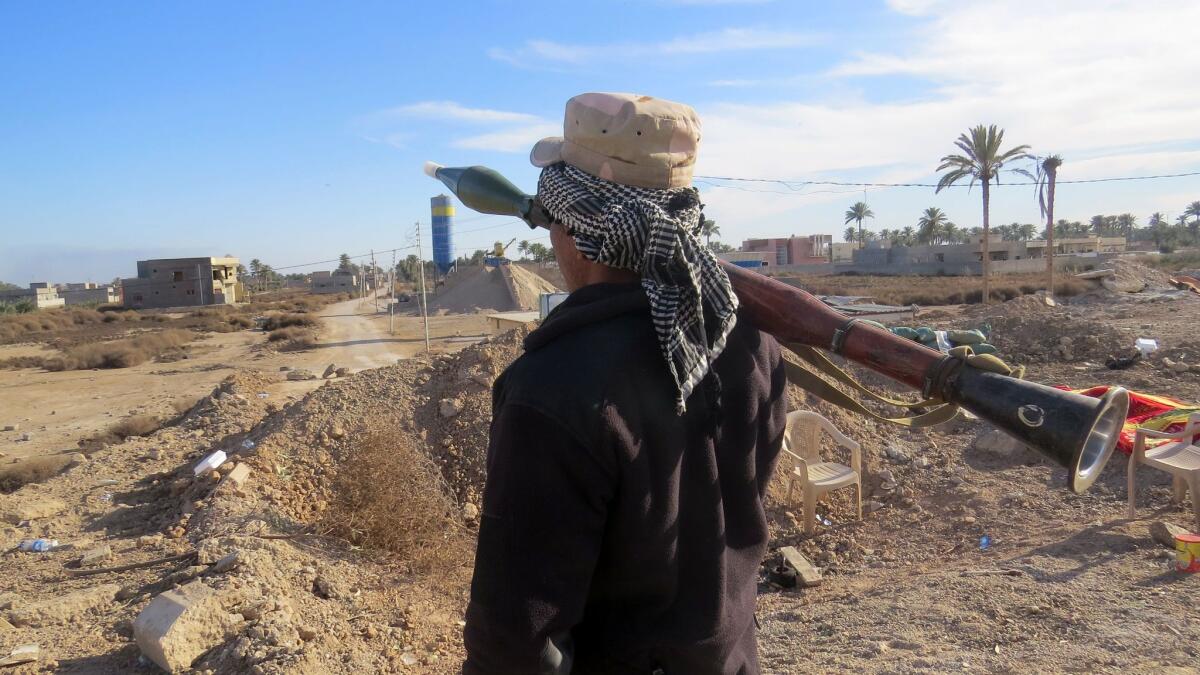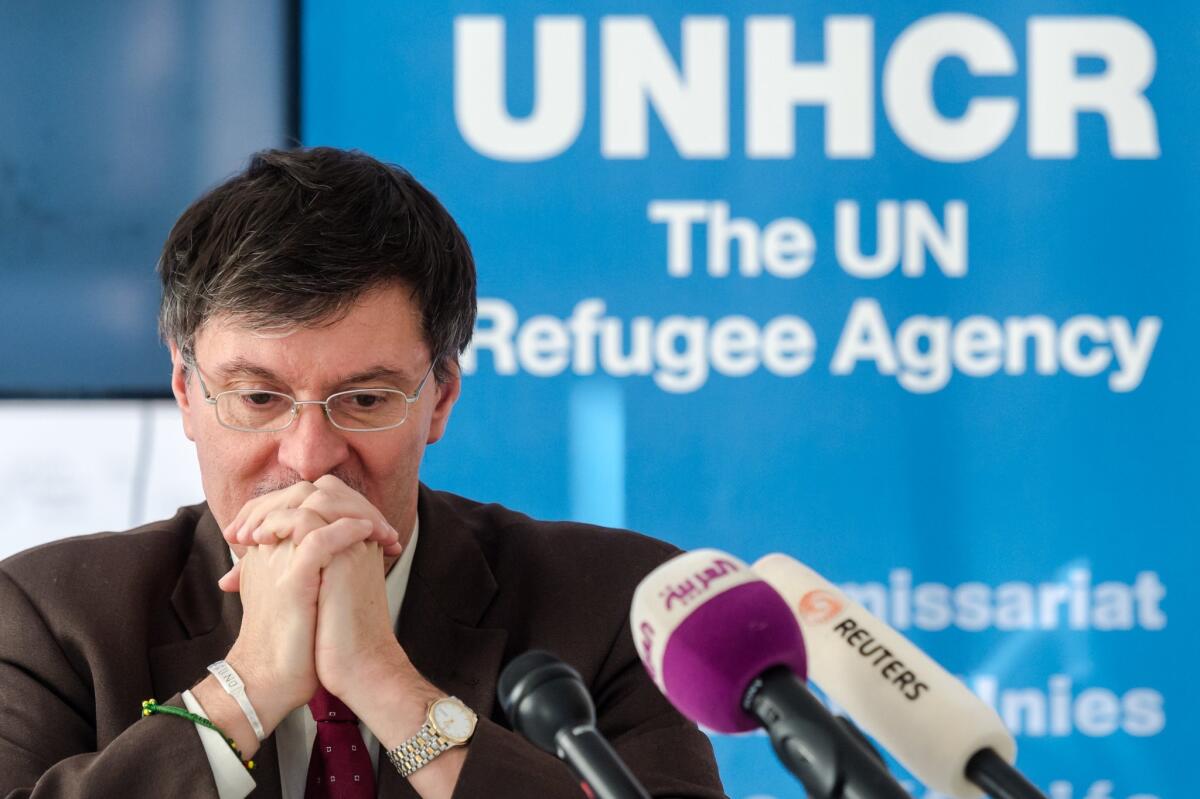Long after most U.S. troops have left Iraq, civilians are dying in ‘obscene’ numbers

A member of the Iraqi security forces holds a rocket-propelled-grenade launcher Jan. 17 during an operation to clear the Sajarya district on the eastern outskirts of Ramadi of Islamic State fighters.
- Share via
Reporting from Beirut — It’s a place where the daily grind — the office commute, a quick trip to the neighborhood market — could end in death, abduction or torture.
Civilians in Iraq face “staggering” violence on a daily basis, according to a United Nations report released Tuesday, which recorded the killings of 18,802 people and almost twice as many wounded between the beginning of 2014 and the end of October 2015. The period covers the government’s battle with the extremist group Islamic State.
Long after the end of major U.S. combat operations in Iraq, the country continues to be torn by sectarian violence that rarely rises to the level of daily headlines but has taken what Jan Kubis, the U.N. special representative in the country, called an “obscene toll on Iraqi civilians and their communities.”
NEWSLETTER: Get the day’s top headlines from Times Editor Davan Maharaj >>
Although the report does not apportion responsibility for the civilian deaths, it makes clear that the U.N. regards Islamic State as the greatest threat to peace. It refers to the group, now headquartered in Syria, as a “scourge” and says it has committed acts that “may, in some cases, amount to war crimes, crimes against humanity, and possibly genocide.”
The 46-page report notes that the numbers of civilian casualties “could be much higher than recorded” because international agencies face difficulties in verifying incidents and accounting for those who died because of “lack of access to basic food, water or medical care.”

In Brussels, U.N. official Bruno Geddo speaks to the media on Tuesday about the humanitarian situation in Iraq.
The violence has also displaced more than 3 million people, a full third of them school-age children, the report says.
It also documents a litany of abuses and human rights violations, whether at the hands of Islamic State or the sectarian militiamen fighting alongside the government to reclaim areas under the Sunni extremist group’s control.
Hundreds of children have been forced to take up arms and fight alongside their militant captors under the threat of being “flogged, tortured or raped.”
The extremist group’s harshest treatment was meted out to the Yazidis, a religious minority whose members are considered to be apostates in Islamic State’s harsh reading of Islamic law.
About 3,500 Yazidi women and children have been coerced into sexual slavery, sold to Islamic State fighters for “between $500 and $2,000,” or given out as prizes in Koran memorization competitions.
Join the conversation on Facebook >>
In mid-2014, Islamic State overran large swaths of northwestern Iraq, including the area of Sinjar, the ancestral home of the Yazidi population.
As Iraqi Kurdish forces retreated, the militants rounded up thousands of Yazidis. They massacred the men and boys while kidnapping the women and forcing them into sexual slavery. The survivors escaped to nearby Sinjar mountain, only to be besieged again by Islamic State forces.
The siege spurred the U.S. to intervene in what grew into an international airstrike campaign aimed at destroying Islamic State.
Despite their steady losses to pro-government forces, the scourge of ISIL continues to kill, maim and displace Iraqi civilians in the thousands and to cause untold suffering.
— Jan Kubis, U.N. special representative in Iraq
Since then, Iraqi forces, in cooperation with the U.S.-led coalition, have fought to dislodge the militants from areas across the country.
The fight has been tortuous. Last week, army units backed by intense airstrikes pummeled their way into the city of Ramadi, 60 miles east of the Iraqi capital, Baghdad.
But many areas remain in Islamic State hands, with the local population at the mercy of the group’s fighters or the cadres of morality police tasked with imposing its draconian laws.
Those who dare to flee or violate Islamic State’s precepts are swiftly shot in the head. Anyone deemed a security threat meets a more barbaric end, in a macabre theater of beheadings, immolation or crucifixion, among others.
“Despite their steady losses to pro-government forces, the scourge of ISIL continues to kill, maim and displace Iraqi civilians in the thousands and to cause untold suffering,” Kubis said in a statement this year, referring to Islamic State by an acronym.
But the possibility of Islamic State being driven away from an area brings little solace to its Sunni inhabitants. Suspected by the Shiite Muslim-dominated government of collaborating with Islamic State, many find themselves under threat from their liberators.
Sectarian tensions in Iraq flared in 2003, when the U.S.-led invasion exacerbated divisions between the country’s Shiite majority and Sunnis, who had enjoyed favored status under strongman Saddam Hussein. The hostilities culminated in a vicious Sunni-Shiite civil war that raged in 2006 and have never fully subsided.
Popular Mobilization Units, Shiite militias fighting alongside government forces, according to the report, operate “outside of government control and perpetuated abuses against civilians, including killings, abductions and destruction of property.”
Images have emerged of militiamen mutilating bodies of combatants or engaging in reprisal killings. One video from 2014 depicts the severed head of what was claimed to be a Sunni sniper put on a stake as Shiite fighters chanted sectarian slogans around it.
But even after combat operations, militiamen set up makeshift checkpoints, apprehending inhabitants and detaining them for days. Other groups conduct targeted, systematic door-to-door searches and raids, with masked gunmen appearing with a list of names of those sought.
Meanwhile, airstrikes targeting civilian infrastructure thought to have been commandeered by Islamic State forces have resulted in hundreds of casualties, according to the report, which acknowledges that “ISIL deliberately bases itself in civilian areas” and “use civilians and civilian infrastructure as shields.”
U.S. Central Command has acknowledged only seven instances of civilian “casualty events,” cases in which civilians were killed or wounded by airstrikes.
But Chris Woods, director of the group Airwars, which monitors the coalition’s airstrikes in Iraq and Syria, said the number was much higher.
Although he lauded the U.S. for its transparency in acknowledging civilian casualties (other members of the coalition claim they have not killed any civilians), he nevertheless estimated that an additional 803 to 1,127 people were killed in “132 problematic coalition strikes since August 2014.”
“With the roughly 9,000 airstrikes from the coalition in Iraq and Syria, these are the figures we would expect to see,” Woods said in a phone interview.
“While the publication of these lists is welcome, we think they are very very slow in tracking the real number of cases and significantly underrepresenting the reality,” he said.
The independent website Iraq Body Count says there is documentary evidence of more than 150,000 civilian deaths in Iraq since the U.S.-led invasion in 2003.
Bulos is a special correspondent.
MORE FROM WORLD
U.S. Embassy says ‘several’ Americans missing in Iraq
Islamic State acknowledges death of ‘Jihadi John’ in magazine
Don’t think that the U.S. and Iran are done butting heads
More to Read
Sign up for Essential California
The most important California stories and recommendations in your inbox every morning.
You may occasionally receive promotional content from the Los Angeles Times.











